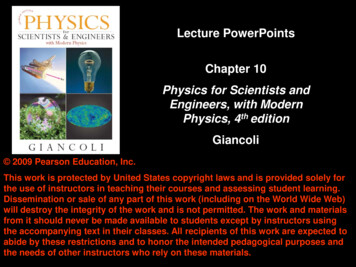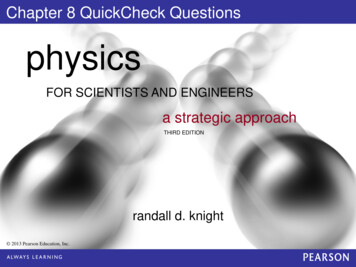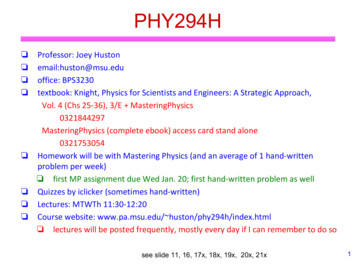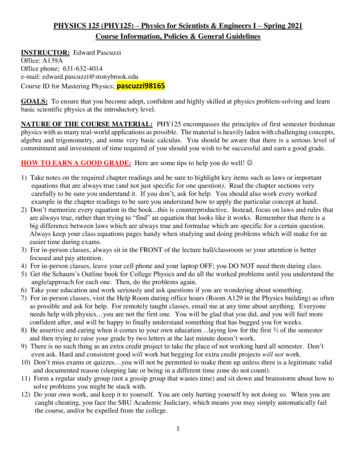
Transcription
Lecture PowerPointsChapter 10Physics for Scientists andEngineers, with ModernPhysics, 4th editionGiancoli 2009 Pearson Education, Inc.This work is protected by United States copyright laws and is provided solely forthe use of instructors in teaching their courses and assessing student learning.Dissemination or sale of any part of this work (including on the World Wide Web)will destroy the integrity of the work and is not permitted. The work and materialsfrom it should never be made available to students except by instructors usingthe accompanying text in their classes. All recipients of this work are expected toabide by these restrictions and to honor the intended pedagogical purposes andthe needs of other instructors who rely on these materials.Copyright 2009 Pearson Education, Inc.
Chapter 10Rotational MotionCopyright 2009 Pearson Education, Inc.
Units of Chapter 10 Angular Quantities Vector Nature of Angular Quantities Constant Angular Acceleration Torque Rotational Dynamics; Torque and RotationalInertia Solving Problems in Rotational DynamicsCopyright 2009 Pearson Education, Inc.
Units of Chapter 10 Determining Moments of Inertia Rotational Kinetic Energy Rotational Plus Translational Motion; Rolling Why Does a Rolling Sphere Slow Down?Copyright 2009 Pearson Education, Inc.
10-1 Angular QuantitiesIn purely rotational motion, allpoints on the object move incircles around the axis ofrotation (“O”). The radius ofthe circle is R. All points on astraight line drawn through theaxis move through the sameangle in the same time. Theangle θ in radians is defined:l,Rwhere l is the arc length.Copyright 2009 Pearson Education, Inc.
10-1 Angular QuantitiesExample 10-1: Birds ofprey—in radians.A particular bird’s eye canjust distinguish objectsthat subtend an angle nosmaller than about 3 x 10-4rad. (a) How many degreesis this? (b) How small anobject can the bird justdistinguish when flying ata height of 100 m?Copyright 2009 Pearson Education, Inc.
10-1 Angular QuantitiesAngular displacement:The average angular velocity isdefined as the total angulardisplacement divided by time:The instantaneous angularvelocity:Copyright 2009 Pearson Education, Inc.
10-1 Angular QuantitiesThe angular acceleration is the rate at which theangular velocity changes with time:The instantaneous acceleration:Copyright 2009 Pearson Education, Inc.
10-1 Angular QuantitiesEvery point on a rotating body has an angularvelocity ω and a linear velocity v.They are related:Copyright 2009 Pearson Education, Inc.
10-1 Angular QuantitiesConceptual Example 10-2: Is the lion fasterthan the horse?On a rotating carousel or merry-go-round,one child sits on a horse near the outer edgeand another child sits on a lion halfway outfrom the center. (a) Which child has thegreater linear velocity? (b) Which child hasthe greater angular velocity?Copyright 2009 Pearson Education, Inc.
10-1 Angular QuantitiesObjects fartherfrom the axis ofrotation will movefaster.Copyright 2009 Pearson Education, Inc.
10-1 Angular QuantitiesIf the angular velocity of arotating object changes, ithas a tangentialacceleration:Even if the angular velocity is constant,each point on the object has a centripetalacceleration:Copyright 2009 Pearson Education, Inc.
10-1 Angular QuantitiesHere is the correspondence between linearand rotational quantities:Copyright 2009 Pearson Education, Inc.
10-1 Angular QuantitiesExample 10-3: Angular and linearvelocities and accelerations.A carousel is initially at rest. At t 0it is given a constant angularacceleration α 0.060 rad/s2, whichincreases its angular velocity for 8.0s. At t 8.0 s, determine themagnitude of the followingquantities: (a) the angular velocity ofthe carousel; (b) the linear velocity ofa child located 2.5 m from the center;(c) the tangential (linear) accelerationof that child; (d) the centripetalacceleration of the child; and (e) thetotal linear acceleration of the child.Copyright 2009 Pearson Education, Inc.
10-1 Angular QuantitiesThe frequency is the number of completerevolutions per second:Frequencies are measured in hertz:The period is the time one revolution takes:Copyright 2009 Pearson Education, Inc.
10-1 Angular QuantitiesExample 10-4: Hard drive.The platter of the hard drive of a computerrotates at 7200 rpm (rpm revolutions perminute rev/min). (a) What is the angularvelocity (rad/s) of the platter? (b) If the readinghead of the drive is located 3.00 cm from therotation axis, what is the linear speed of thepoint on the platter just below it? (c) If a singlebit requires 0.50 μm of length along thedirection of motion, how many bits per secondcan the writing head write when it is 3.00 cmfrom the axis?Copyright 2009 Pearson Education, Inc.
10-1 Angular QuantitiesExample 10-5: Given ω as function of time.A disk of radius R 3.0 m rotates at an angularvelocity ω (1.6 1.2t) rad/s, where t is inseconds. At the instant t 2.0 s, determine (a)the angular acceleration, and (b) the speed vand the components of the acceleration a of apoint on the edge of the disk.Copyright 2009 Pearson Education, Inc.
10-2 Vector Nature of Angular QuantitiesThe angular velocity vector points along the axisof rotation, with the direction given by the righthand rule. If the direction of the rotation axisdoes not change, the angular acceleration vectorpoints along it as well.Copyright 2009 Pearson Education, Inc.
10-3 Constant Angular AccelerationThe equations of motion for constant angularacceleration are the same as those for linearmotion, with the substitution of the angularquantities for the linear ones.Copyright 2009 Pearson Education, Inc.
10-3 Constant Angular AccelerationExample 10-6: Centrifuge acceleration.A centrifuge rotor is accelerated from rest to20,000 rpm in 30 s. (a) What is its averageangular acceleration? (b) Through how manyrevolutions has the centrifuge rotor turnedduring its acceleration period, assumingconstant angular acceleration?Copyright 2009 Pearson Education, Inc.
10-4 TorqueTo make an object start rotating, a force isneeded; the position and direction of the forcematter as well.The perpendicular distance from the axis ofrotation to the line along which the force acts iscalled the lever arm.Copyright 2009 Pearson Education, Inc.
10-4 TorqueA longer leverarm is veryhelpful inrotating objects.Copyright 2009 Pearson Education, Inc.
10-4 TorqueHere, the lever arm for FA is the distance fromthe knob to the hinge; the lever arm for FD iszero; and the lever arm for FC is as shown.Copyright 2009 Pearson Education, Inc.
10-4 TorqueThe torque is definedas:Copyright 2009 Pearson Education, Inc.
10-4 TorqueExample 10-7: Torque on a compound wheel.Two thin disk-shapedwheels, of radii RA 30cm and RB 50 cm, areattached to each other onan axle that passesthrough the center ofeach, as shown. Calculatethe net torque on thiscompound wheel due tothe two forces shown,each of magnitude 50 N.Copyright 2009 Pearson Education, Inc.
10-5 Rotational Dynamics; Torque andRotational InertiaKnowing that, we see thatThis is for a single pointmass; what about anextended object?RCopyright 2009 Pearson Education, Inc.As the angularacceleration is the samefor the whole object, wecan write:
10-5 Rotational Dynamics; Torque andRotational InertiaThe quantityis called therotational inertia of an object.The distribution of mass matters here—thesetwo objects have the same mass, but the one onthe left has a greater rotational inertia, as somuch of its mass is far from the axis of rotation.Copyright 2009 Pearson Education, Inc.
10-5 RotationalDynamics; Torqueand RotationalInertiaThe rotational inertia ofan object depends notonly on its massdistribution but also thelocation of the axis ofrotation—compare (f)and (g), for example.Copyright 2009 Pearson Education, Inc.
10-6 Solving Problems in RotationalDynamics1. Draw a diagram.2. Decide what the system comprises.3. Draw a free-body diagram for each objectunder consideration, including all the forcesacting on it and where they act.4. Find the axis of rotation; calculate the torquesaround it.Copyright 2009 Pearson Education, Inc.
10-6 Solving Problems in RotationalDynamics5. Apply Newton’s second law for rotation. Ifthe rotational inertia is not provided, youneed to find it before proceeding with thisstep.6. Apply Newton’s second law for translationand other laws and principles as needed.7. Solve.8. Check your answer for units and correctorder of magnitude.Copyright 2009 Pearson Education, Inc.
10-7 Determining Moments of InertiaIf a physical object is available, the momentof inertia can be measured experimentally.Otherwise, if the object can be consideredto be a continuous distribution of mass, themoment of inertia may be calculated:Copyright 2009 Pearson Education, Inc.
10-7 Determining Moments of InertiaExample 10-12: Cylinder,solid or hollow.(a) Show that the momentof inertia of a uniformhollow cylinder of innerradius R1, outer radius R2,and mass M, is I ½M(R12 R22), if the rotationaxis is through the centeralong the axis ofsymmetry. (b) Obtain themoment of inertia for asolid cylinder.Copyright 2009 Pearson Education, Inc.
10-7 Determining Moments of InertiaThe parallel-axis theorem gives themoment of inertia about any axisparallel to an axis that goes through thecenter of mass of an object:Copyright 2009 Pearson Education, Inc.
10-7 Determining Moments of InertiaExample 10-13: Parallel axis.Determine the moment ofinertia of a solid cylinder ofradius R0 and mass M aboutan axis tangent to its edgeand parallel to its symmetryaxis.Copyright 2009 Pearson Education, Inc.
10-7 Determining Moments of InertiaThe perpendicular-axis theorem is valid onlyfor flat objects.Copyright 2009 Pearson Education, Inc.
10-8 Rotational Kinetic EnergyThe kinetic energy of a rotating object is givenbyBy substituting the rotational quantities, we findthat the rotational kinetic energy can be written:A object that both translational and rotationalmotion also has both translational and rotationalkinetic energy:Copyright 2009 Pearson Education, Inc.
10-8 Rotational Kinetic EnergyWhen using conservation of energy, bothrotational and translational kinetic energy mustbe taken into account.All these objects have the same potential energyat the top, but the time it takes them to get downthe incline depends on how much rotationalinertia they have.Copyright 2009 Pearson Education, Inc.
10-8 Rotational Kinetic EnergyThe torque does work as it moves the wheelthrough an angle θ:Copyright 2009 Pearson Education, Inc.
10-9 Rotational Plus Translational Motion;RollingIn (a), a wheel is rolling withoutslipping. The point P, touchingthe ground, is instantaneouslyat rest, and the center moveswith velocity v.In (b) the same wheel is seenfrom a reference frame where Cis at rest. Now point P is moving with velocity – v .The linear speed of the wheel isrelated to its angular speed:Copyright 2009 Pearson Education, Inc.
10-10 Why Does a Rolling Sphere SlowDown?A rolling sphere will slow down and stop ratherthan roll forever. What force would cause this?If we say “friction”, there are problems: The frictional force has toact at the point of contact;this means the angularspeed of the sphere wouldincrease. Gravity and the normalforce both act through thecenter of mass, and cannotcreate a torque.Copyright 2009 Pearson Education, Inc.
10-10 Why Does a Rolling Sphere SlowDown?The solution: No real sphere is perfectly rigid.The bottom will deform, and the normal forcewill create a torque that slows the sphere.Copyright 2009 Pearson Education, Inc.
Summary of Chapter 10 Angles are measured in radians; a whole circle is2π radians. Angular velocity is the rate of change of angularposition. Angular acceleration is the rate of change ofangular velocity. The angular velocity and acceleration can berelated to the linear velocity and acceleration. The frequency is the number of full revolutionsper second; the period is the inverse of thefrequency.Copyright 2009 Pearson Education, Inc.
Summary of Chapter 10, cont. The equations for rotational motion with constantangular acceleration have the same form as thosefor linear motion with constant acceleration. Torque is the product of force and lever arm. The rotational inertia depends not only on themass of an object but also on the way its mass isdistributed around the axis of rotation. The angular acceleration is proportional to thetorque and inversely proportional to the rotationalinertia.Copyright 2009 Pearson Education, Inc.
Summary of Chapter 10, cont. An object that is rotating has rotational kineticenergy. If it is translating as well, the translationalkinetic energy must be added to the rotational tofind the total kinetic energy. Angular momentum is If the net torque on an object is zero, its angularmomentum does not change.Copyright 2009 Pearson Education, Inc.
10-1 Angular Quantities Example 10-3: Angular and linear velocities and accelerations. A carousel is initially at rest. At t 0 it is given a constant angular acceleration α 0.060 rad/s2, which increases its angular velocity for 8.0 s. At t 8.0 s, determine the magnitude of the following











